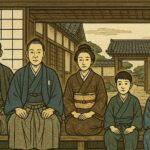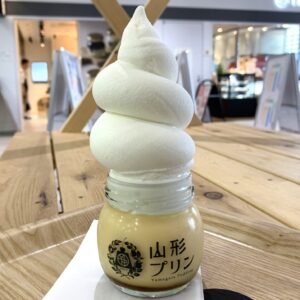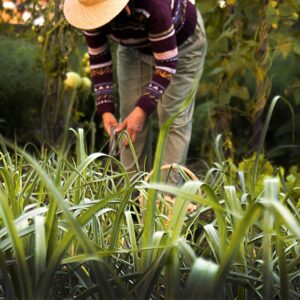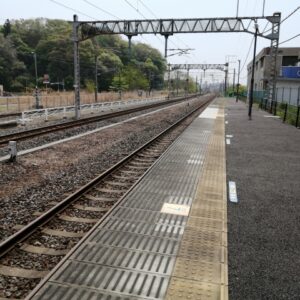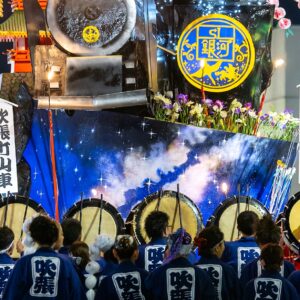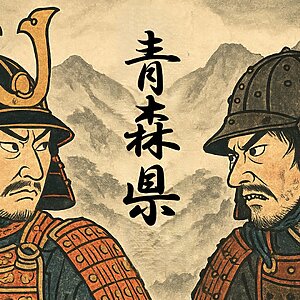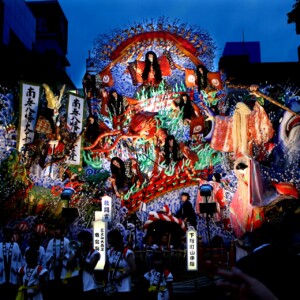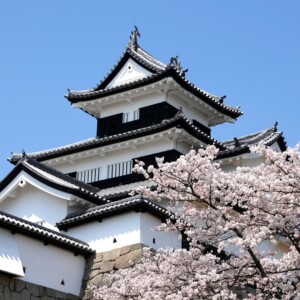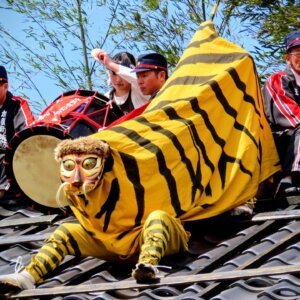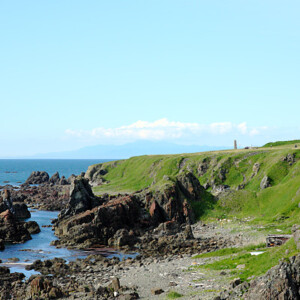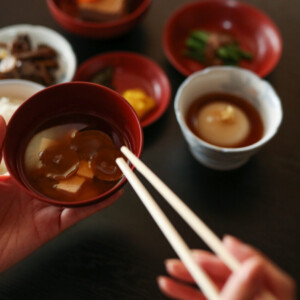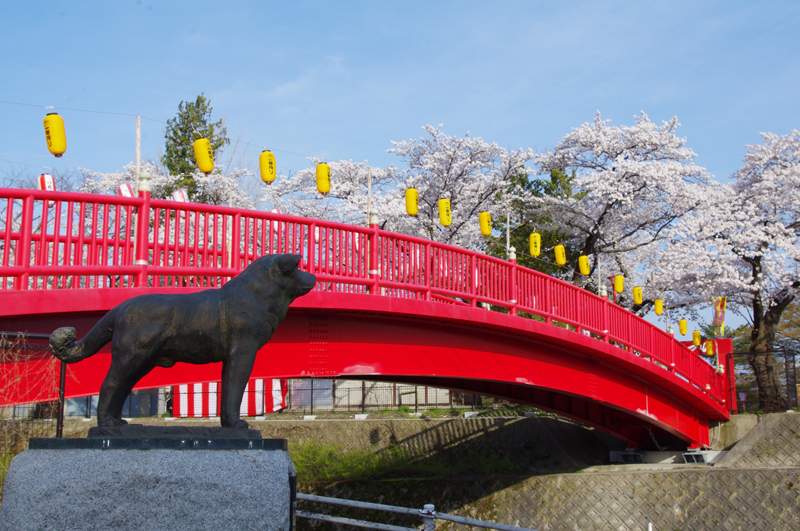
The history of Odate, which played an important role in the borders of the domain during the Meiji Restoration [Akita Prefecture]
table of contents
- 1 In the first half of the Edo period, Odate was in trouble due to feudal boundaries.
- 2 The center of the boundary dispute with the Tsugaru domain is Yatate Pass on the Ushu Highway.
- 3 The border with the Nanbu domain took over 70 years to resolve.
- 4 Odate Castle was spared from demolition as an exception to the Edo Shogunate's One Country One Castle Order.
- 5 The Boshin War shocked Odate, which had lived through a peaceful era.
- 6 The Odate Castle ruins have been developed as Katsura Castle Park and become a place for citizens to relax.
- 7 Odate Hachiman Shrine, where valuable buildings from the Edo period remain
In the first half of the Edo period, Odate was in trouble due to feudal boundaries.
Odate known for its Akita dogs, Hinai Jichiri chickens, and Kiritanpo , was located in the easternmost part of the Kubota domain (Akita domain) during the Edo period.
To the north is the territory of the Tsugaru Domain and to the east is the territory of the Nanbu Domain, and there are constant riots around the boundary, and finally, a huge uproar was caused involving the Edo Shogunate as well.
Kakunodate City and Kosaka Town, which are currently the east of Odate City, are local governments in Akita Prefecture, but Kakunodate City and Kosaka Town were incorporated into Akita Prefecture after the Meiji period, and were the territory of the Nanbu Domain during the Edo period.
As a result, the Kubota Domain had a powerful castle lord living in Odate Castle, and glaring at the Tsugaru Domain and Nanbu Domain.
The center of the boundary dispute with the Tsugaru domain is Yatate Pass on the Ushu Highway.

Odate was run by the Ushu Kaido Road, which connects Edo and the Tohoku region.
you will need to cross Yatate Toge, surrounded by thick Akita cedar forests
Since ancient times, Yatate Pass was the boundary between the two domains, but it seems that no clear location had been decided. At Yatate Pass, a little further down from the top of the pass to the Tsugaru Domain "Yatate Cedar ," which was a marker of the border of the domain.
According to legend, during the Heian period, in order to determine the border between Dewa Province (Akita Prefecture and Yamagata Prefecture) and Mutsu Province (Aomori Prefecture), the boundary was decided by the cedar (Yata Cedar) that was hit by an arrow by fire at a mountain pass, but when the two domains decided on the border, the Tsugaru Domain claimed that the border was the summit of Yatate Pass.
In the Kubota Domain, we thought that Yatatesugi was the landmark for the border as before, so it's difficult to decide.
A battle to decide borders that lasted 150 years
There was no choice but to entrust the two domains with the Edo Shogunate to mediate. The shogunate's ruling was considered to be "Yatashisugi," but after that, the Tsugaru Domain was not convinced and continued to flirt with endless flirting.
In the end, the Tsugaru Domain also recognized the boundary as Yatashisugi, but this was only until 1746 in the mid-Edo period, and during that time it had been competing for nearly 150 years.
Since the Meiji period, the prefectural border between Akita Prefecture and Aomori Prefecture has been around Yatatesugi, and Yatatesugi is on the Akita Prefecture side. The Yatate cedar has since been broken or felled, but now the third generation has planted it on the stump of the old Yatate cedar as a symbol of the prefectural border.
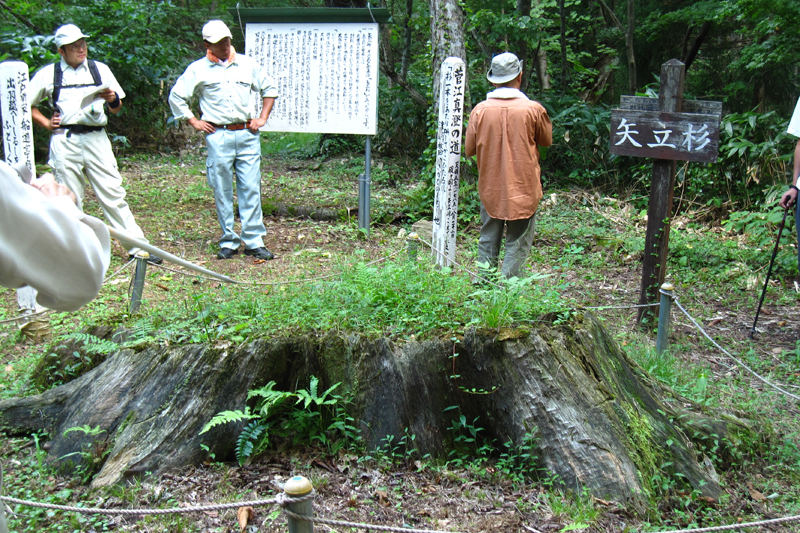
Yatate Pass is a treasure trove of Akita Cedar. It is currently a well-maintained and a great walk course
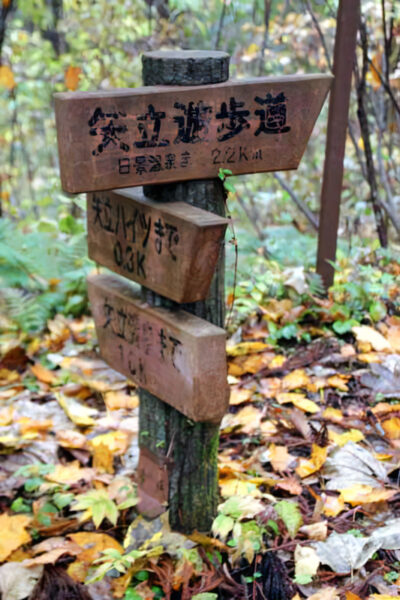
The area around Yatate Cedar and Yatate Pass is protected as "Yasuragi Forest" and "Yatate Pass Scenery Forest" the "History Road, Yatate Pass Promenade" is developed.
A walking course has been created through the forest filled with natural Akita cedars, mainly along the Furushu Kaido, and signs are erected at key points, so you can walk safely without getting lost.
the Roadside Station Yatate Toge located along the current Ushu Kaido Road (National Route 7) . The roadside station parking lot can be used for strolling, and there is a pamphlet on the walkway inside the building. There are also many wildlife such as bears, so be sure to gather information from staff who know the surrounding area well before walking.
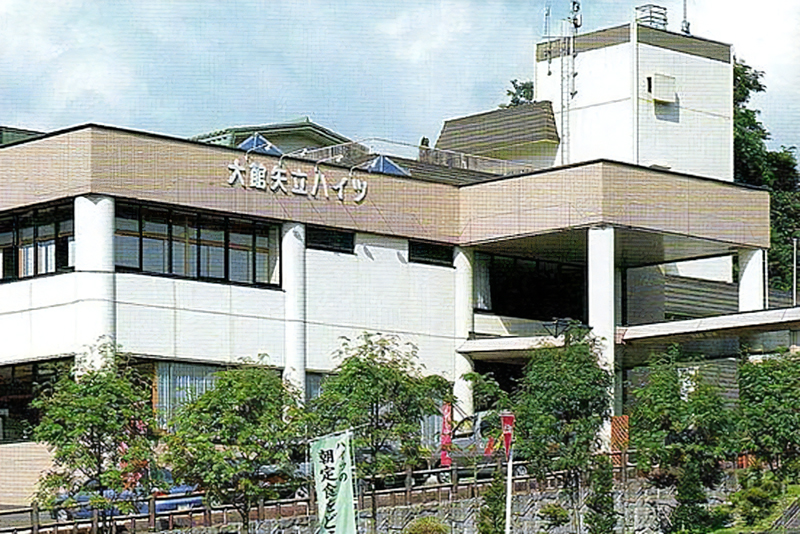
``Roadside Station Yatate Pass'' is attached to the hot spring accommodation facility ``Odate Yatate Heights,'' The shortest distance from the roadside station to Yatatesugi is about 300 meters.
"Odate Yatate Heights" is close to the old Ou Main Line Yatate Tunnel ruins, which was known for its triple steam locomotive runs, and is a convenient lodging facility as a base for sightseeing in Odate City's famous and historic sites. The local cuisine is also outstanding. The natural hot springs containing sodium and calcium chloride will soothe your daily fatigue.
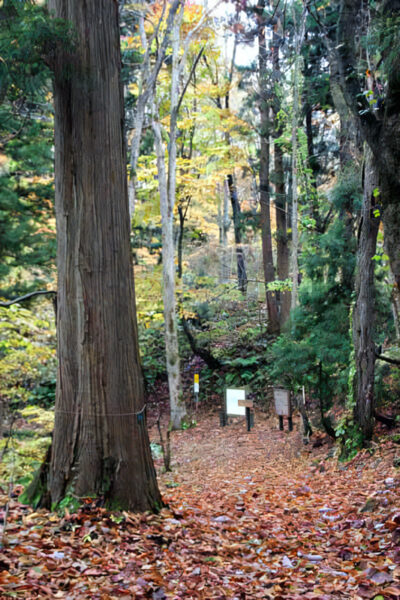
Yatate Pass Promenade <Information>
- Historical Road Yatate Pass Promenade
- Facility name: Roadside station “Yatetoge”/Odate Yatate Heights
- Location: 311 Jinba, Mayor Odate, Akita Prefecture
- Phone number: 0186-51-2311
- Please check the homepage or travel site for accommodation fees.
- <One-day hot spring>
- Usage hours: 10:00-15:00
- Fee (shared room break included): 700 yen for junior high school students and above, 400 yen for elementary school students
- URL: Roadside station "Yatetoge"/"Odate Yatate Heights"
- access:
- Railway/About 25 minutes by taxi from JR Ou Main Line Odate Station
- Car: Approximately 7 minutes from Ikarigaseki IC on the Tohoku Expressway, approximately 20 minutes from Odate-kita IC on the Akita Expressway
Google Map
The border with the Nanbu domain took over 70 years to resolve.
The border with the southern domain to the east is also difficult to determine. Therefore, officials from the Kubota domain and the Nanbu domain visited Edo many times and held discussions with the shogunate, and it was not until 1677 that an agreement was finally reached.
Odate Castle was spared from demolition as an exception to the Edo Shogunate's One Country One Castle Order.
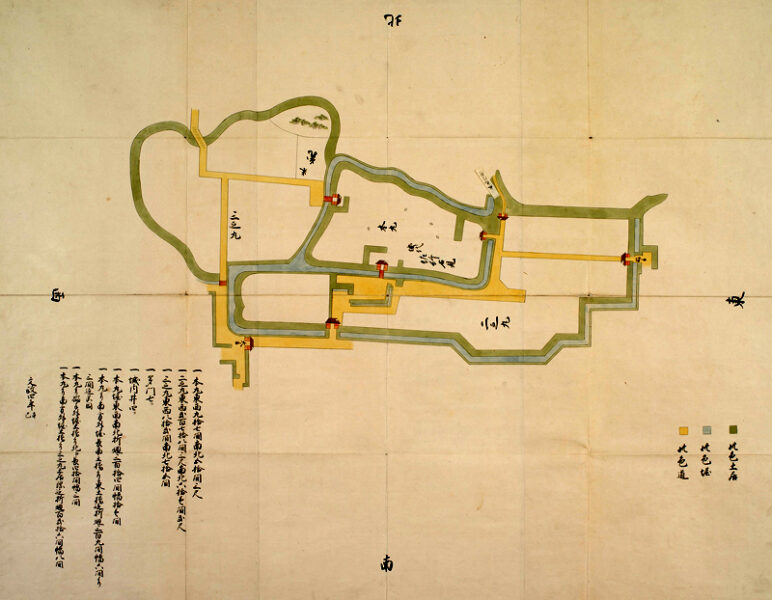
Odate Castle was built by the Asari clan, which owned the Odate that had been known as Hinai after the Kamakura period, but the Asari clan lost the battle for the family's headship and was cut off.
There have been some changes, such as the Ando clan of Noshiro temporarily settling the castle and the Nanbu Domain, and at the end of the Sengoku period, it became the residence of the Akita clan (formerly Ando clan), which was based at the time by Toyotomi Hideyoshi, at the time, which was based on Akita Castle and ruled the Akita region.
In the Edo period, Tokugawa Ieyasu moved the Akita clan to Hitachi Province (Ibaraki Prefecture), and instead moved the daimyo Satake clan of Hitachi Province to Akita.
Odate Castle was also a castle for the Satake clan, but the Satake clan built its castle in Kubota (Akita City) on the Sea of Japan side, so vassals were sent to Odate Castle. At this time, the original lords of Odate Castle and others opposed the Satake clan and a fight broke out, but in 1610, Obayoshinari (Obayoshinari) suppressed him and became the lord of the castle.
In 1615, the Edo Shogunate suddenly issued an Ikkoku Ichijo Rei, and said that only one castle would be recognized by a single domain (domain = country). The Kubota Domain is based at Kubota Castle, so Odate Castle was destined to be abandoned.
However, the Kubota Domain also recognized Odate Castle and Yokote Castle as official castles. The reason simply means that the land is wide and governed will be difficult.
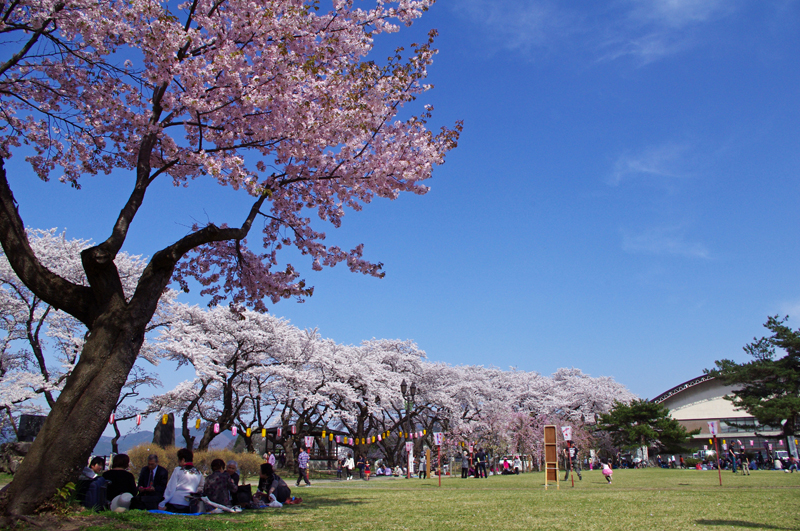
Yoshinari Oba, the first castle lord of Odate Castle, was a cousin of Yoshinobu Satake, the first lord of the Kubota domain, and Yoshifusa, the third generation from Yoshinari, was allowed to use the surname Satake. Furthermore, during the 6th generation, Yoshimura, the name came to be called "Satake Nishiie". Since then, the Satake family of Odate has been called "Nishie" or "Onishi-sama."
The Boshin War shocked Odate, which had lived through a peaceful era.
Odate has been a peaceful era until the end of the Edo period, after the boundary problem was resolved. However, the Meiji Restoration caused devastating damage to Odate. The Boshin War broke out in 1868 .
In 1867, the Satsuma domain (Kagoshima prefecture) and the Choshu domain (Yamaguchi prefecture) formed an alliance and staged a coup d'état, forcing the 15th Shogun of the Edo shogunate, Yoshinobu Tokugawa, to acknowledge the return of sovereignty to the Emperor (Taisei Hokan). ). The coup d'état was completed bloodlessly, and a new government was established centered on the Satcho clan and the Tosa clan (Kochi prefecture).
However, those who were not satisfied with this rebelled against the new government and clashed with the new government's forces in Kyoto in January 1868. This was the ``Battle of Toba-Fushimi,'' and it was the beginning of the Boshin War. The Boshin War spread across the country as the new government army marched north.
Odate Castle, joined the new government forces and became the forefront of the Kubota Domain
In the Tohoku region, many domains, mainly the Aizu Domain (Fukushima Prefecture) and the Nanbu Domain, united as anti-new governments, and together with some domains in the Hokuriku region, the "Ouetsu Domain Alliance" and challenged the new government forces to fight. The Kubota Domain initially joined the Alliance of the Alliance, but with the persuasive government forces, they left on July 4, 1868, and most of the other domains became enemies.
The Nanbu Domain, angry at the Kubota Domain's withdrawal, began an attack on the Kubota Domain on August 9th. Odate has become a battlefield.
The Nanbu Domain, which initially boasted overwhelming military strength, fell to Odate Castle on August 22nd, and the castle town was almost turned to ashes.
After that, the Kubota clan's army, which received reinforcements from the new government forces, regained Odate on September 6th. As a result, Odate Castle was the only loss to the Kubota Domain, and Kubota Castle ended the war without being injured.
The Odate Castle ruins have been developed as Katsura Castle Park and become a place for citizens to relax.
All buildings at Odate Castle were burned down during the Boshin War. The castle ruins are being maintained as Katsura Castle Park
Katsura Castle was named after Odate Castle was called "Katsurajo." Although there are no buildings, some moats and stone walls from that time remain, and many cherry blossoms are planted in the garden, and many citizens and tourists visit the spring cherry blossom festival.
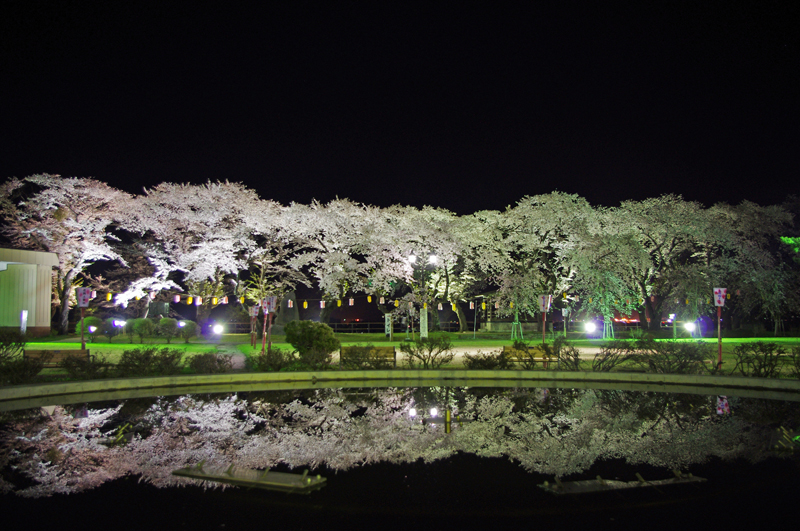
Katsurajo Park <Information>
- Facility name: Katsuragi Park
- Location: Nakagusuku, Odate City, Akita Prefecture
- Phone number: 0186-43-7072 (Odate City Industry Department Tourism Division)
- Railway: Approximately 10 minutes by bus from Odate Station on the JR Ou Main Line, approximately 1 minute walk from Odate City Hall bus stop, approximately 20 minutes walk from Higashi-Odate Station on the JR Hanawa Line.
- Car: Approximately 30 minutes from Kosaka IC on the Tohoku Expressway
Google Map
Odate Hachiman Shrine, where valuable buildings from the Edo period remain
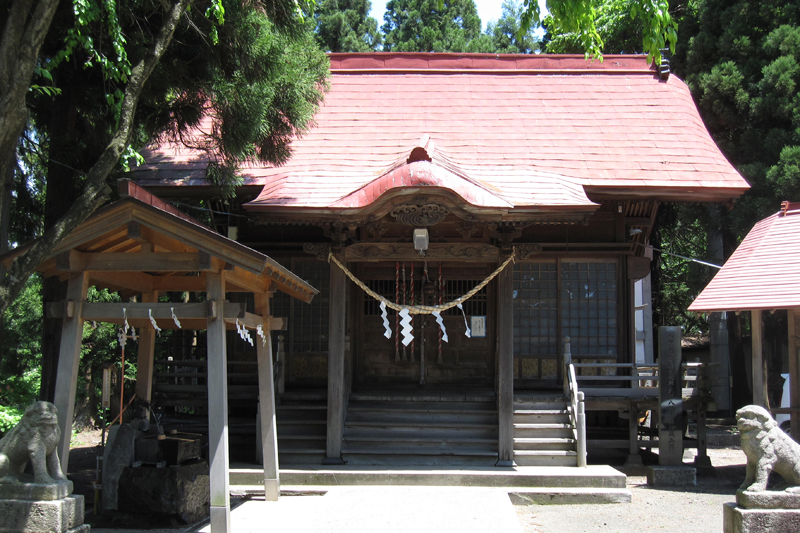
There are almost no buildings left in the old castle town of Odate City, which suffered devastating damage during the Boshin War, but miraculously Odate Hachiman Shrine , which was located at the east end of Odate Castle, was built in the Edo period. It is still standing as it was in the past. The main shrine was built in 1687, and is a very valuable building built in the architectural style of the early Edo period, and has been designated as an important national cultural property.
Odate Hachiman Shrine <Information>
- Facility name: Odate Hachiman Shrine
- Location: 1 Yahata, Odate City, Akita Prefecture
- Phone number: 0186-42-1328
- Free walk around the grounds
- URL: Odate Hachiman Shrine
- access:
- Railway: Approximately 35 minutes on foot from Odate Station on the JR Ou Main Line, approximately 25 minutes on foot from Higashi-Odate Station
- Car: Approximately 10 minutes from Akita Expressway Odate-Minami IC or Odate-Kita IC





![Yokote's history and current cityscape, which has been the setting for many conflicts [Akita Prefecture] B9a8a63b4f44230DD4393E5583Fadc97](https://jp.neft.asia/wp-content/uploads/2023/07/b9a8a63b4f44230dd4393e5583fadc97-150x150.jpg)
![Hiyama Ando clan, ruled Akita during the Sengoku period and based in Noshiro [Akita Prefecture] Akita Fan](https://jp.neft.asia/wp-content/uploads/2025/03/0275d341934f847be3452ea4662d9a4e-150x150.jpg)
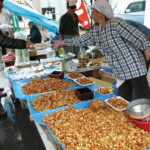
![The battle for bone flesh unfolded in Yokote Basin: "Three Years of Second Year Battle" [Akita Prefecture] 0fb6939d60ada03f05f13ef893cd6663](https://jp.neft.asia/wp-content/uploads/2023/07/0fb6939d60ada03f05f13ef893cd6663-150x150.jpg)
![Akita dogs are treasures in Japan! The Akita Inu Preservation Society in Odate City strictly manages pedigree [Akita Prefecture] Akita dog](https://jp.neft.asia/wp-content/uploads/2024/01/25534593_m-150x150.jpg)
![[Akita Prefecture] Let's stay at a roadside station! Introducing roadside stations with accommodation facilities in Akita Prefecture! Akita Catch](https://jp.neft.asia/wp-content/uploads/2024/09/979a38324ff45520e274bdc0cee6df5e-150x150.jpg)
![Hot springs gush out in a place where there are no volcanoes! "Yuzawa Geopark" where you can see the mystery of the earth up close [Akita Prefecture] 4550228_m](https://jp.neft.asia/wp-content/uploads/2023/02/4550228_m-150x150.jpg)
